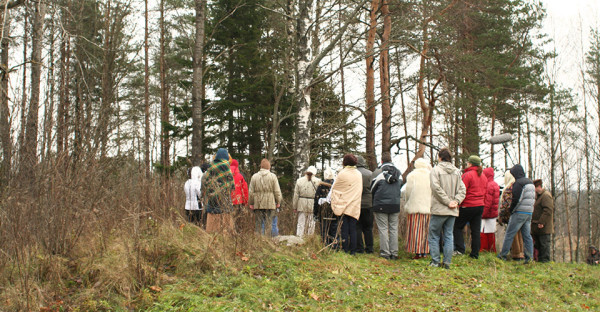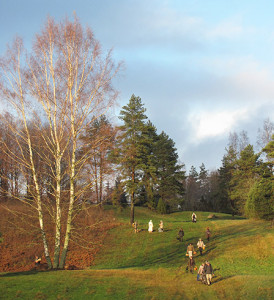
The Sacred Natural Sites Initiative regularly features “Conservation Experiences” of custodians, protected area managers, and others that stand to protect sacred sites. This post features the experiences of Mr. Arvi Sepp from the ‘Estonian House of Taara and Native Religions’ which protects and revitalises sacred natural sites all over Estonia. Arvi Sepp and his colleagues at Maavalla Koda have worked on the national uptake of the Estonian translation of the IUCN UNESCO Guidelines, which has been undertaken as part of a broader national strategy of sensibilisation and inventory of sacred natural sites.

Prayer and gathering on the Sacred Forest Hill in Paluküla (Paluküla hiiemägi, Paluküla village, Rapla parish, central Estonia) at the Souls Time, November 2008. (Photo: Auli Kütt).
In 2008, the Estonian Ministry of Culture approved the national conservation plan “Sacred Natural Sites in Estonia: Study and Maintenance 2008 – 2012”. Some 7000 sacred natural sites have thus far been registered, but most of them are unprotected by law because they fall between the cracks of natural and cultural heritage legislation. This is also the case with Paluküla, the Sacred Forest Hill, and Arvi Sepp has long been supporting the movement to protect the hill from unsustainable exploitation and development through informing planning authorities and other groups lobbying for the development of sports facilities. Click here to read the full case study on “Paluküla, Sacred Forest Hill”.
Before the Crusades in the 13th century, al local villages shared sacred natural sites. That still form a pattern in the landscape today. In the Paluküla village area in Central Estonia lays a Sacred Forest Hill called Hiiemägi (“hiis-hill”). Here, numerous local people still worship nature as a divinity and hey offer the first harvest of the year at to the ancestors who are associated with Hiiemägi and the trees that are not to be cut and the hill cannot be ploughed or otherwise disturbed. The worshippers formed an association to protect the Paluküla Sacred Forest Hill. The association acts as a custodian of the hill and aims to study and conserve the sacred site and communicate with other organisations.

Coming down the Sacred Forest Hill (Hiiemägi=Hiis-hill) in Paluküla after gathering.
(Photo: Kadi-Ann Kraut)
Almost all villagers say that the hill is important for them but some people are divided by influences from outside such as commercialisation of land use, building and development and possible EU interference. The administration of the Kehtna municipality is set to build a sports and recreation centre on one side of the hill which would require excavation and the construction of skiing lifts within the nature conservation area.
Sacred natural sites throughout Estonia should be protected and the institutions dealing with natural and cultural heritage management need to be equipped to support conservation efforts by custodians. These special places, where human activity does not dominate over nature, unite nature and heritage and at the same time have the sacred dimension. In this case of Paluküla, the half-open southern hillside could be used for sliding in winter for the foreseeable future, but without artificial constructions. The site can furthermore serve as a living example for nature education, introducing cultural conservation practices to a broad audience.
Hiiemägi is protected as the Kõnnumaa nature conservation area in the Natura 2000 network. The Estonian law does not recognize sacred natural sites, but does recognize archaeological and natural sites as protected. Draft legislation has been written by a group within the parliament, to amend both the Heritage Conservation Act and the Nature Conservation Act of Estonia. Sacred natural sites should be seen as a special type of monument, with corresponding rules of protection.
Click here to read the full case study on “Paluküla, Sacred Forest Hill”.






